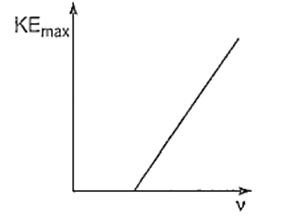 Multiple Choice Questions
Multiple Choice QuestionsAccording to Einstein's photoelectric equation, the graph of KE of the photoelectron emitted from the metal versus the frequency of the incident radiation gives a straight line graph, whose slope
depends on the intensity of the incident radiation
depends on the nature of the metal and also on the intensity of incident radiation
is same for all metals and independent of the intensity of the incident radiation
depends on the nature of the metal
C.
is same for all metals and independent of the intensity of the incident radiation
According to Einstein's photoelectric equation

KEmax = hv − Φ0
Comparing with the equation of straight line
y = mx + c
We get, slope of graph = h
The photoelectric threshold wavelength for silver is M. The energy of the electron ejected from the surface of silver by an incident wavelength λ (λ < λ0) will be
hc (λ0 − λ)
When an electron jumps from the orbit n = 2 to n = 4, then wavelength of the radiations absorbed will be (R is Rydberg's constant)
n photons of wavelength λ are absorbed by a black body of mass m. The momentum gained by the body is
Light emitted during the de excitation of electron from n = 3 to n = 2, when incident on a metal, photoelectrons are just emitted from that metal. In which of the following de excitations photoelectric effect is not possible ?
From n = 2 to n = 1
From n = 3 to n = 1
From n = 5 to n = 2
From n = 4 to n = 3
Maximum velocity of the photoelectron emitted by a metal is 1.8 x 106 ms-1. Take the value of specific charge of the electron is 1.8 x 1011 C kg-1. Then the stopping potential in volt is
1
3
9
6
The maximum kinetic energy of the photoelectrons depends only on
potential
frequency
incident angle
pressure
Light of two different frequencies whose photons have energies 1 eV and 2.5 eV respectively, successively illuminate a metallic surface whose work function is 0.5 eV. Ratio of maximum speeds of emitted electrons will be
1 : 2
1 : 5
1 : 1
1 : 4
The variation of photocurrent with collector potential for different frequencies of incident radiation v1, v2 and v3 is as shown in the graph, then

v1 = v2 = v3
v1 > v2 > v3
v1 < v2 < v3
From the following graph of photo current against collector plate potential, for two different intensities of light I1 and I2, one can conclude

I1 = I2
I1 > I2
I1 < I2
Comparision is not possible
